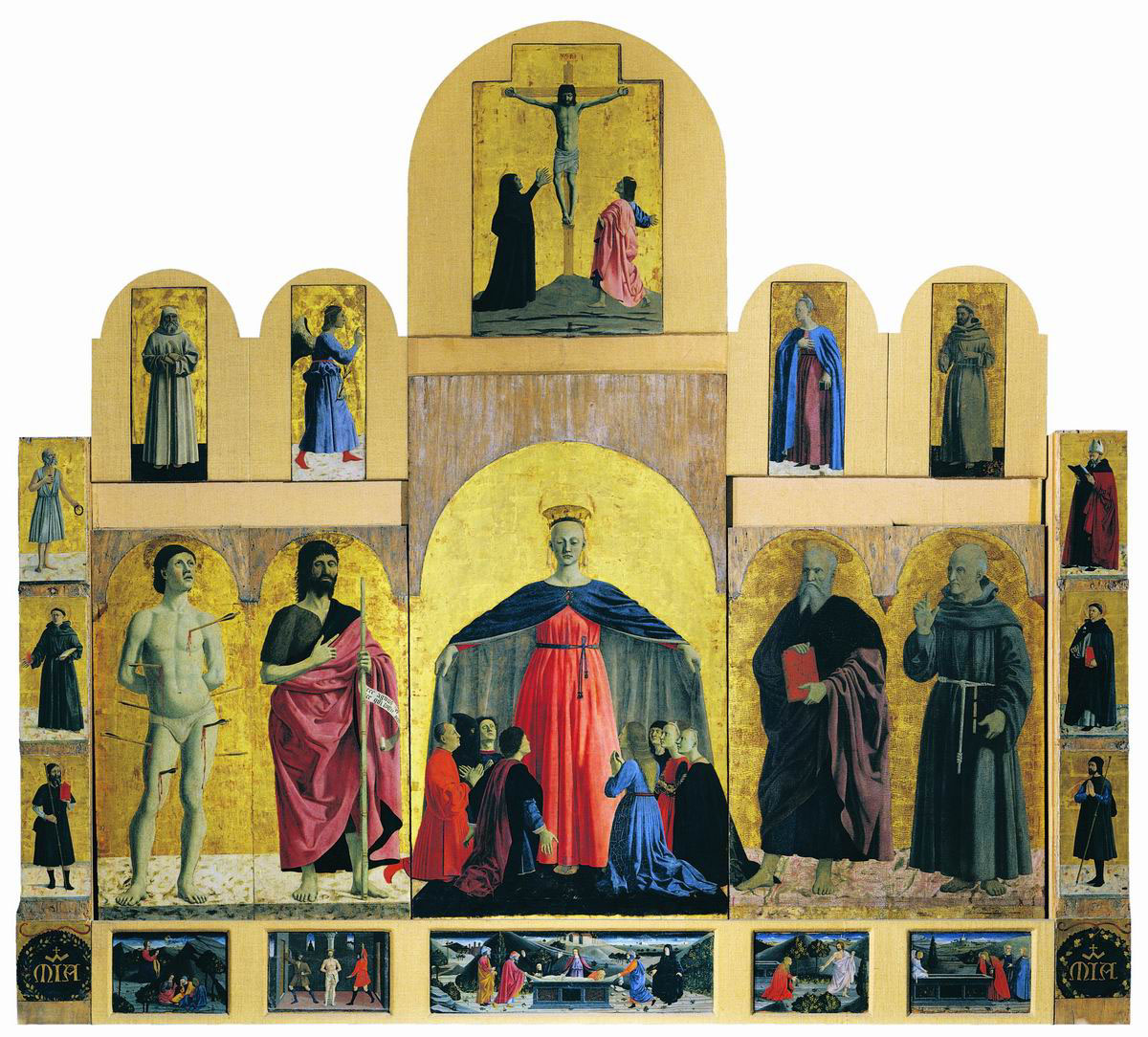Polyptych of the Misericordia on:
[Wikipedia]
[Google]
[Amazon]
The ''Polyptych of the Misericordia'' is a painting conserved in the Museo Civico di Sansepolcro in the town of Sansepolcro, region of  In 1445, the Compagnia della Misericordia, a
In 1445, the Compagnia della Misericordia, a
Tuscany
it, Toscano (man) it, Toscana (woman)
, population_note =
, population_blank1_title =
, population_blank1 =
, demographics_type1 = Citizenship
, demographics1_footnotes =
, demographics1_title1 = Italian
, demogra ...
, Italy. The painting is one of the earliest works of the Italian Renaissance
The Italian Renaissance ( it, Rinascimento ) was a period in Italian history covering the 15th and 16th centuries. The period is known for the initial development of the broader Renaissance culture that spread across Europe and marked the trans ...
painter Piero della Francesca, who was born in the town. The central panel is of the common motif of the '' Virgin of Mercy'' or ''Madonna della Misericordia''.
 In 1445, the Compagnia della Misericordia, a
In 1445, the Compagnia della Misericordia, a confraternity
A confraternity ( es, cofradía; pt, confraria) is generally a Christian voluntary association of laypeople created for the purpose of promoting special works of Christian charity or piety, and approved by the Church hierarchy. They are most c ...
of Borgo San Sepolcro, commissioned Piero, a native of the town, to paint a polyptych
A polyptych ( ; Greek: ''poly-'' "many" and ''ptychē'' "fold") is a painting (usually panel painting) which is divided into sections, or panels. Specifically, a "diptych" is a two-part work of art; a " triptych" is a three-part work; a tetrapt ...
for them. According to the taste of the time, the polyptych was to be painted with precious colours and have a gilded background. Piero did not respect the three-year time limit set in the contract—he was busy working on many other projects. The polyptych was only finished seventeen years later, in 1462.
The oldest two panels, to the left of the main panel, depict St Sebastian
Saint Sebastian (in Latin: ''Sebastianus''; Narbo, Gallia Narbonensis, Roman Empire c. AD 255 – Rome, Italia, Roman Empire c. AD 288) was an early Christian saint and martyr. According to traditional belief, he was killed during the Diocle ...
and St John the Baptist
John the Baptist or , , or , ;Wetterau, Bruce. ''World history''. New York: Henry Holt and Company. 1994. syc, ܝܘܿܚܲܢܵܢ ܡܲܥܡܕ݂ܵܢܵܐ, Yoḥanān Maʿmḏānā; he, יוחנן המטביל, Yohanān HaMatbil; la, Ioannes Bapti ...
. St Sebastian's panel shows a close connection with Masaccio
Masaccio (, , ; December 21, 1401 – summer 1428), born Tommaso di Ser Giovanni di Simone, was a Florentine artist who is regarded as the first great Italian painter of the Quattrocento period of the Italian Renaissance. According to Vasar ...
's nudes, which Piero would have seen in an early visit to Florence
Florence ( ; it, Firenze ) is a city in Central Italy and the capital city of the Tuscany region. It is the most populated city in Tuscany, with 383,083 inhabitants in 2016, and over 1,520,000 in its metropolitan area.Bilancio demografico ...
. Piero painted the outlying panels of the tympanum later; including the Crucifixion at the top centre, St Benedict, the Angel, the ''Madonna of the Annunciation'', and St Francis in the sides. Towards 1450 he finished the figures of St. Andrew and St. Bernardino. The predella
In art a predella (plural predelle) is the lowest part of an altarpiece, sometimes forming a platform or step, and the painting or sculpture along it, at the bottom of an altarpiece, sometimes with a single much larger main scene above, but oft ...
s, with five scenes of Jesus's life, were mostly executed by assistants.
The last part of the polyptych to be painted was the main central panel showing the ''Madonna della Misericordia''. The panel portrays the mercifully protective gesture of the Madonna enfolding her followers in her mantle.
Piero resolves the difficulty of dealing with a flat solid gilded background, requested by the patrons, by placing the kneeling members of the confraternity (who commissioned the altarpiece
An altarpiece is an artwork such as a painting, sculpture or relief representing a religious subject made for placing at the back of or behind the altar of a Christian church. Though most commonly used for a single work of art such as a painting ...
) in the realistic three-dimensional space created by the Madonna's mantle, a space resembling the apse of a church. Notably, the Madonna is still portrayed larger in size than the human figures, a tradition in medieval painting. However, the fully three-dimensional rendering of the figure, inspired by Masaccio, and the perspective study, inspired by Brunelleschi
Filippo Brunelleschi ( , , also known as Pippo; 1377 – 15 April 1446), considered to be a founding father of Renaissance architecture, was an Italian architect, designer, and sculptor, and is now recognized to be the first modern engineer, ...
, are plainly of the Renaissance.
See also
*Consecration and entrustment to Mary
The consecration and entrustment to the Virgin Mary is a personal or collective act of Marian devotion among Catholics, with the Latin terms ''oblatio'', ''servitus'', ''commendatio'' and ''dedicatio'' being used in this context. Consecration is a ...
References